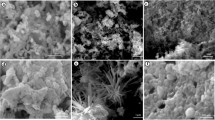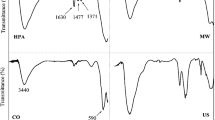Abstract
Zinc oxide (ZnO) powders have been prepared by solution combustion synthesis method using conventional and microwave ignition routes. The effects of starting solution acidity on the combustion behavior, phase evolution, microstructure, optical properties and photocatalytic performance were investigated by thermal analysis, X-ray diffractometry, electron microscopy and diffuse reflectance spectrometry techniques. The chelated species in dried gels were predicted by theoretical calculations and confirmed by Fourier transform infrared spectroscopy. The combustion reaction rate increased with the increase of pH values. Single phase and well-crystalline ZnO powders were achieved by both of ignition methods regardless of pH values. The hexagonal particles (200–80 nm) formed by microwave ignition were larger than the spherical particles (60–40 nm) in conventional heating. Conventionally combusted ZnO powders exhibited higher photocatalytic activity under ultraviolet irradiation, due to their narrower band gap and smaller particle size.

C/C0 vs. irradiation time for photodegradation of MB dye under ultraviolet light irradiation by the as-combusted ZnO powders (filled symbols present conventional combusted powders and open symbols are for the microwave combusted powders)








Similar content being viewed by others
References
Raoufi D (2013) Synthesis and microstructural properties of ZnO nanoparticles prepared by precipitation method. Renew Energy 50:932–937
Li M, Hari B, Lv X, Ma X, Sun F, Tang L, Wang Z (2007) Direct synthesis of monodispersed ZnO nanoparticles in an aqueous solution. Mater Lett 61:690–693
Huang J, Wu Y, Gu C, Zhai M, Yu K, Yang M, Liu J (2010) Large-scale synthesis of flowerlike ZnO nanostructure by a simple chemical solution route and its gas-sensing property. Sens Actuat B Chem 146:206–212
Jeong I-S, Kim JH, Im S (2003) Ultraviolet-enhanced photodiode employing n-ZnO/p-Si structure. Appl Phys Lett 83:2946–2948
Lee D, Ki Bae W, Park I, Yoon DY, Lee S, Lee C (2011) Transparent electrode with ZnO nanoparticles in tandem organic solar cells. Sol Energy Mater Sol Cells 95:365–368
Sun J-H, Dong S-Y, Feng J-L, Yin X-J, Zhao X-C (2011) Enhanced sunlight photocatalytic performance of Sn-doped ZnO for methylene blue degradation. J Mol Catal A Chem 335:145–150
Zhijian W, Haiming Z, Ligong Z, Jinshan Y, Shenggang Y, Chunyan W (2003) Low-temperature synthesis of ZnO nanoparticles by solid-state pyrolytic reaction. Nanotechnology 14:11
Ristić M, Musić S, Ivanda M, Popović S (2005) Sol–gel synthesis and characterization of nanocrystalline ZnO powders. J Alloy Compd 397:L1–L4
Reddy AJ, Kokila MK, Nagabhushana H, Rao JL, Shivakumara C, Nagabhushana BM, Chakradhar RPS (2011) Combustion synthesis, characterization and Raman studies of ZnO nanopowders. Spectrochim Acta Part A Mol Biomol Spectrosc 81:53–58
Sunandan B, Joydeep D (2009) Hydrothermal growth of ZnO nanostructures. Sci Technol Adv Mater 10:013001
Varma A, Mukasyan AS, Rogachev AS, Manukyan KV (2016) Solution combustion synthesis of nanoscale materials. Chem Rev 116:14493–14586
Wen W, Wu J-M (2014) Nanomaterials via solution combustion synthesis: a step nearer to controllability. RSC Adv 4:58090–58100
Li F-t, Ran J, Jaroniec M, Qiao SZ (2015) Solution combustion synthesis of metal oxide nanomaterials for energy storage and conversion. Nanoscale 7:17590–17610
Nersisyan HH, Lee JH, Ding J-R, Kim K-S, Manukyan KV, Mukasyan AS (2017) Combustion synthesis of zero-, one-, two- and three-dimensional nanostructures: current trends and future perspectives. Progress Energy Combust Sci 63:79–118
Fathi H, Masoudpanah SM, Alamolhoda S, Parnianfar H (2017) Effect of fuel type on the microstructure and magnetic properties of solution combusted Fe3O4 powders. Ceram Int 43:7448–7453
Parnianfar H, Masoudpanah SM, Alamolhoda S, Fathi H (2017) Mixture of fuels for solution combustion synthesis of porous Fe3O4 powders. J Magn Magn Mater 432:24–29
Radpour M, Masoudpanah SM, Alamolhoda S (2017) Microwave-assisted solution combustion synthesis of Fe3O4 powders. Ceram Int 43:14756–14762
Radpour M, Alamolhoda S, Masoudpanah SM (2017) Effects of pH value on the microstructure and magnetic properties of solution combusted Fe3O4 powders. Ceram Int 43:13729–13734
Pourgolmohammad B, Masoudpanah SM, Aboutalebi MR (2017) Effect of starting solution acidity on the characteristics of CoFe2O4 powders prepared by solution combustion synthesis. J Magn Magn Mater 424:352–358
Potti PR, Srivastava VC (2012) Comparative studies on structural, optical, and textural properties of combustion derived ZnO prepared using various fuels and their photocatalytic activity. Ind Eng Chem Res 51:7948–7956
Nehru LC, Swaminathan V, Sanjeeviraja C (2012) Rapid synthesis of nanocrystalline ZnO by a microwave-assisted combustion method. Powder Technol 226:29–33
Manukyan KV, Chen Y-S, Rouvimov S, Li P, Li X, Dong S, Liu X, Furdyna JK, Orlov A, Bernstein GH, Porod W, Roslyakov S, Mukasyan AS (2014) Ultrasmall α-Fe2O3 superparamagnetic nanoparticles with high magnetization prepared by template-assisted combustion process. J Phys Chem C 118:16264–16271
Kitchen HJ, Vallance SR, Kennedy JL, Tapia-Ruiz N, Carassiti L, Harrison A, Whittaker AG, Drysdale TD, Kingman SW, Gregory DH (2014) Modern microwave methods in solid-state inorganic materials chemistry: from fundamentals to manufacturing. Chem Rev 114:1170–1206
Mukasyan AS, Rogachev AS, Aruna ST (2015) Combustion synthesis in nanostructured reactive systems. Adv Powder Technol 26:954–976
Naderi P, Masoudpanah SM, Alamolhoda S (2017) Magnetic properties of Li0.5Fe2.5O4 nanoparticles synthesized by solution combustion method. Appl Phys A 123:702
Junliang L, Wei Z, Cuijing G, Yanwei Z (2009) Synthesis and magnetic properties of quasi-single domain M-type barium hexaferrite powders via sol–gel auto-combustion: effects of pH and the ratio of citric acid to metal ions (CA/M). J Alloy Compd 479:863–869
Masoudpanah SM, Seyyed Ebrahimi SA (2011) Effect of pH value on the structural and magnetic properties of nanocrystalline strontium hexaferrite thin films. J Magn Magn Mater 323:2643–2647
Socrates G (2001) Infrared and Raman characteristic group frequencies, 1 ed. Wiley, New York, NY
Nakamoto K, Nakamoto K (1977) Infrared and Raman spectra of inorganic and coordination compounds. Wiley, New York, NY
Priyanka VC Srivastava (2013) Photocatalytic oxidation of dye bearing wastewater by iron doped zinc oxide Ind Eng Chem Res 52:17790–17799
Pourgolmohammad B, Masoudpanah SM, Aboutalebi MR (2017) Effects of the fuel type and fuel content on the specific surface area and magnetic properties of solution combusted CoFe2O4 nanoparticles. Ceram Int 43:8262–8268
Barbooti MM, Al-Sammerrai DA (1986) Thermal decomposition of citric acid. Thermochim Acta 98:119–126
Erri P, Pranda P, Varma A (2004) Oxidizer−fuel interactions in aqueous combustion synthesis. 1. Iron(III) nitrate−model fuels. Ind Eng Chem Res 43:3092–3096
Pathak TK, Kumar A, Swart CW, Swart HC, Kroon RE (2016) Effect of fuel content on luminescence and antibacterial properties of zinc oxide nanocrystalline powders synthesized by the combustion method. RSC Adv 6:97770–97782
Zheng W, Ding R, Yan X, He G (2017) PEG induced tunable morphology and band gap of ZnO. Mater Lett 201:85–88
Yusoff N, Ho L-N, Ong S-A, Wong Y-S, Khalik W (2016) Photocatalytic activity of zinc oxide (ZnO) synthesized through different methods. Desalin Water Treat 57:12496–12507
Klubnuan S, Suwanboon S, Amornpitoksuk P (2016) Effects of optical band gap energy, band tail energy and particle shape on photocatalytic activities of different ZnO nanostructures prepared by a hydrothermal method. Opt Mater 53:134–141
Nagaraju G, Shivaraju GC, Banuprakash G, Rangappa D (2017) Photocatalytic activity of ZnO nanoparticles: synthesis via solution combustion method. Mater Today Proc 4:11700–11705
Tripathy N, Ahmad R, Kuk H, Hahn Y-B, Khang G (2016) Mesoporous ZnO nanoclusters as an ultra-active photocatalyst. Ceram Int 42:9519–9526
Author information
Authors and Affiliations
Corresponding author
Ethics declarations
Conflict of interest
The authors declare that they have no conflict of interest.
Additional information
Highlights
-
ZnO powders were synthesized via conventional and microwave solution combustion methods.
-
The characteristics of as-combusted ZnO powders were compared at various pH values.
-
Particle size decreased with the increase of pH values for both heating processes.
-
The band gap energy increased in the range of 3.08–3.21 eV.
-
The highest photodegradation of methylene blue was achieved in conventional heating.
Rights and permissions
About this article
Cite this article
Kalantari Bolaghi, Z., Masoudpanah, S.M. & Hasheminiasari, M. Photocatalytic properties of ZnO powders synthesized by conventional and microwave-assisted solution combustion method. J Sol-Gel Sci Technol 86, 711–718 (2018). https://doi.org/10.1007/s10971-018-4658-2
Received:
Accepted:
Published:
Issue Date:
DOI: https://doi.org/10.1007/s10971-018-4658-2




